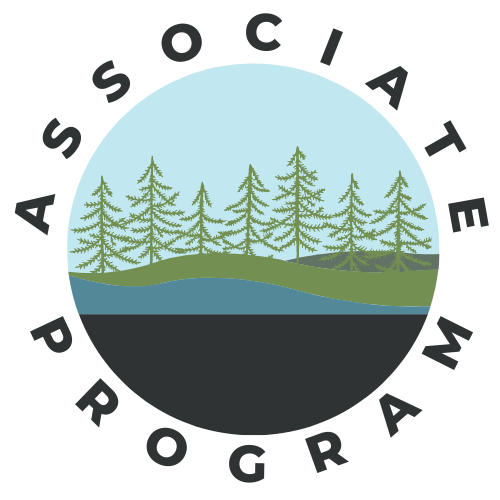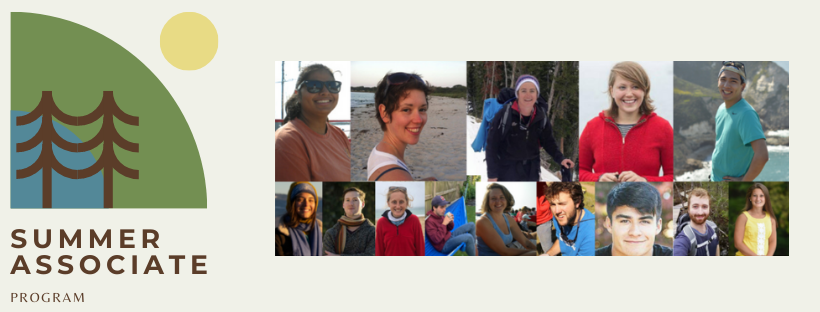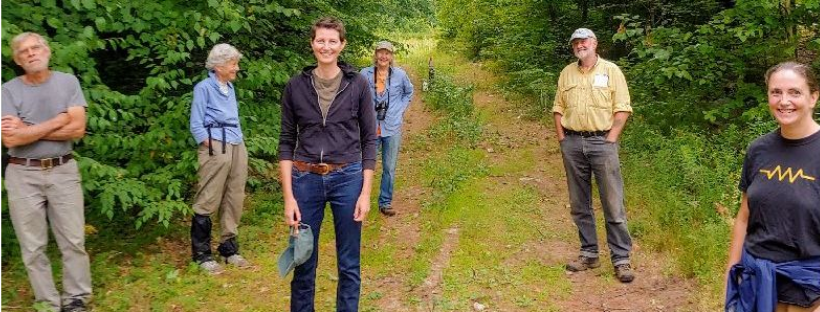Category: News
OUTLOOK with Natalie Meenan
Outlook explores variables that shape and influence individuals relationships with nature and how they seek to inspire, adapt and reimagine what conservation can look like moving forward in a world where Climate Change is affecting a broad range of human and natural systems.
Author: Chas Van Damme, SMCC Summer Associate. A rising senior at Bates College studying Environmental Studies with a focus in Global Environmental Politics.
OUTLOOK: An afternoon “WALK & TALK” with Natalie Meenan, beach surveyor with the Maine Geological Survey.
A couple days ago, while droves of seagulls swept around in front of my favorite beach spot, stealthily making a lunch out of what was seemingly some little kid’s cheese sticks, I couldn’t help but dream about what it would be like to bask endlessly under the sun, listening to streams of waves crash against the sandy shoreline. For Natalie Meenan this dream is somewhat of an everyday reality. The important distinction being that she is not basking at all, but instead toting a large GPS contraption across miles of several beaches in Southern Maine as a surveyor with the Maine Geological Survey (MGS).
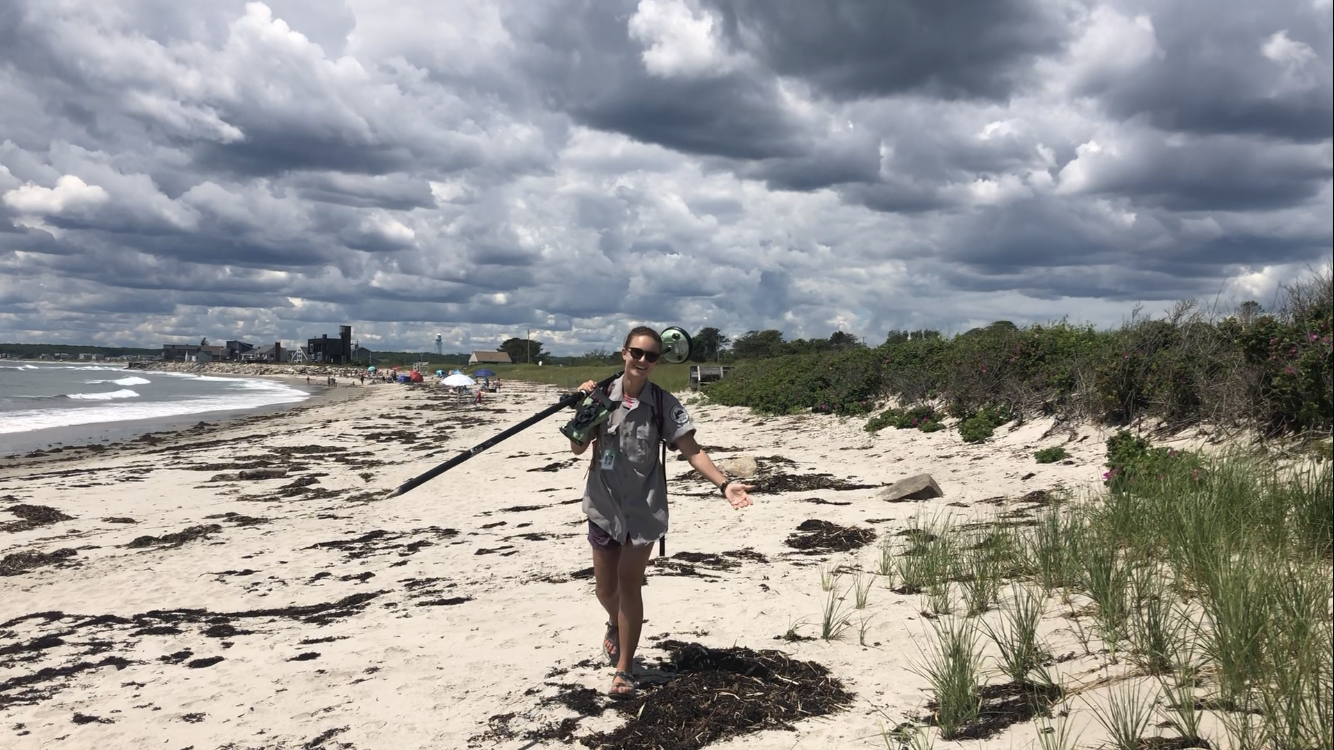
I recently had the privilege of joining Natalie on one of her surveying days at Fortunes Rock Beach in Biddeford to pick her brain about her work, interests, and thoughts on climate change. Originally from Friday Harbor, Washington, where several years of guiding kayak tours nurtured an appreciation for the outdoors, she now finds herself as far as she could possibly get from home: studying Geology at Bates College in Lewiston, ME. On our walk, she described a pressing need to address the ever-growing impacts of climate change, focusing particularly on the coast where sea level rise and erosion are perhaps most easily visible. It’s this motivation that drew her to work as a coastal intern with the MGS this summer.
As we walked the coastline, Natalie explained the technical aspects of her work. Her (very fancy) GPS system tracks her every movement, logging both the mean high water line and dune line at a given beach. These variables are particularly important in analyzing the changes in coastal environments as they inform research into sea level rise, dune recession, habitat destruction, and much more. When compared with the 15+ years of previous surveying work done on locations like Fortunes Rock, we are able to see just how quickly coastlines are shifting. Every two years, the data that folks like Natalie collect is pooled together and analyzed in MGS’ State of Maine’s Beaches Report, which provides key insight for town and state-level policymakers hoping to remediate the coastal impacts of climate change.
“When it comes to coastal environments like beaches,” Natalie noted, “change is completely natural – dunes will recede, the high water line will fluctuate, and sediment will find itself new homes. What is concerning, however, is that these environments are changing at unprecedented rates.”
Human-induced climate change is speeding up these processes and sharpening the teeth of their impacts. In response, residents along coastlines are working to adapt to these new realities by building up seawalls, rewilding and reinforcing dunes, and finding ways to protect sensitive areas. As you see below, a few of these attempts were evident at Fortunes Rock.
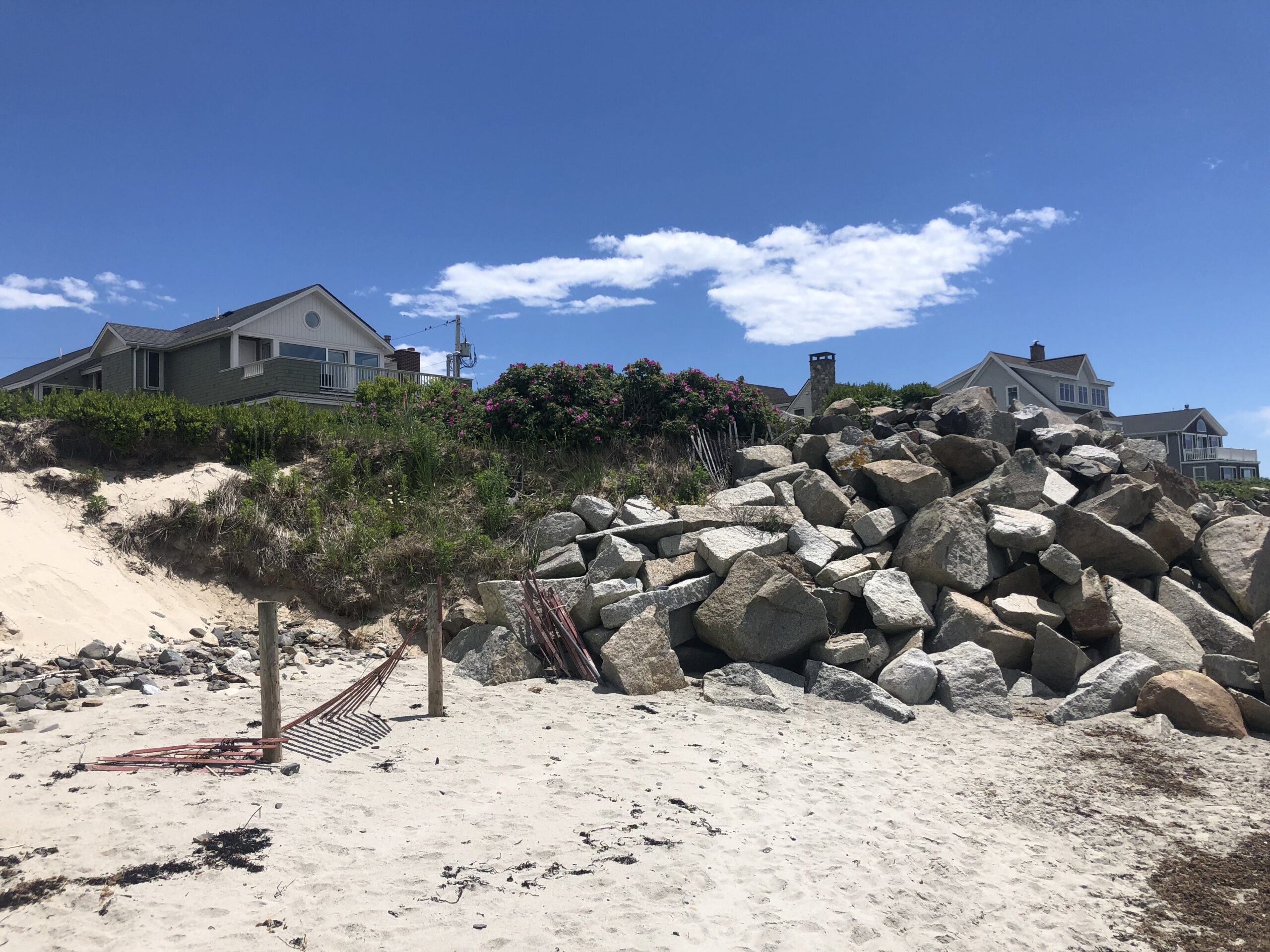
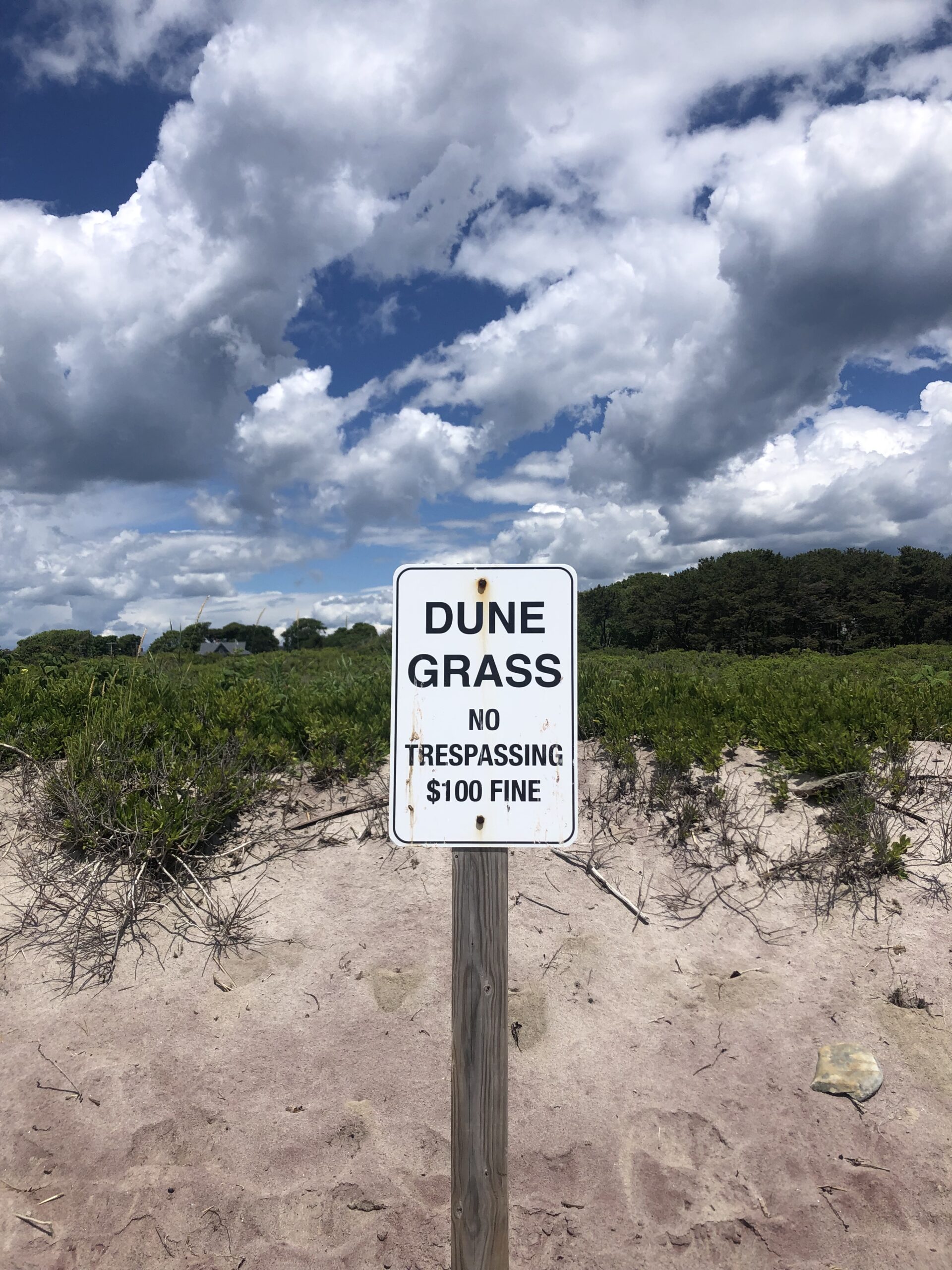
But to what extent is climate adaptation sustainable? Homes built on beaches will always be subject to gradual natural environmental changes. As these changes grow in scale is adaptation potentially becoming a feat of futility? The large boulders lodged along the northern end of Fortunes Rock Beach might speak to this. For now, they are doing their job of protecting the beautiful homes above them, but the dunes just 10 feet south are continuing to recede. What’s next? Install barriers to protect those dunes? Potentially explore natural erosion-prevention measures such as planting native beach grasses? There is no clear-cut answer. Yet one thing’s for certain: so long as we depend on living along coastlines, adaptation will be an ongoing process requiring new ideas, innovations, and research from hardworking people like Natalie.
Research has always been foundational in the pursuit of climate resolution – a concept that the Climate Change Observatory Network is no stranger to. Natalie and I noted that the presence of a Climate Change Observatory site in places like Fortunes Rock could facilitate the documentation of coastal changes. By pooling a series of photographs of a given location over a long period of time, these sites provide a visual repository of change. When seen in tandem with the data collected by people like Natalie, CCO sites would help guide us on the steps toward climate resilience.
I am thankful to Natalie for allowing me the time to join her on such a lovely expedition, even if it meant pestering her with too many questions!
CCON News: LELT Hacker’s Hill Preserve Restoration Project
Loon Echo Land Trust (LELT) has been working with EcoConservation Services, LLC to control japanese knotweed (scientific name: Fallopia japonica) at Hacker’s Hill Preserve. Cheri Brunault, has been working closely with LELT on this dense knotweed stand (about 0.15 acres), attempting to reduce the stand’s vigor. LELT also partnered with the Southern Maine Conservation Collaborative to install a Climate Change Observatory post that will help monitor this restoration project and document the changes occurring of time.
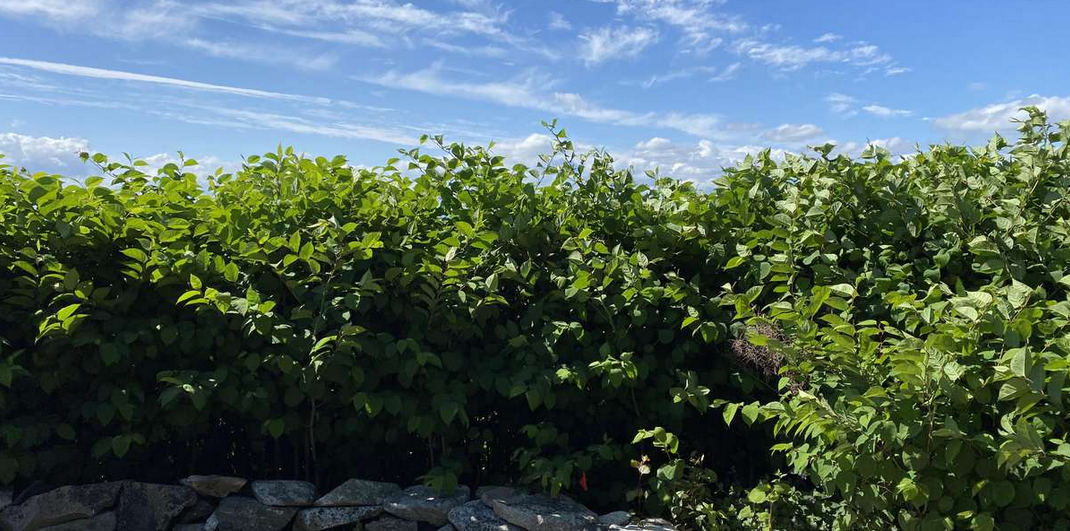
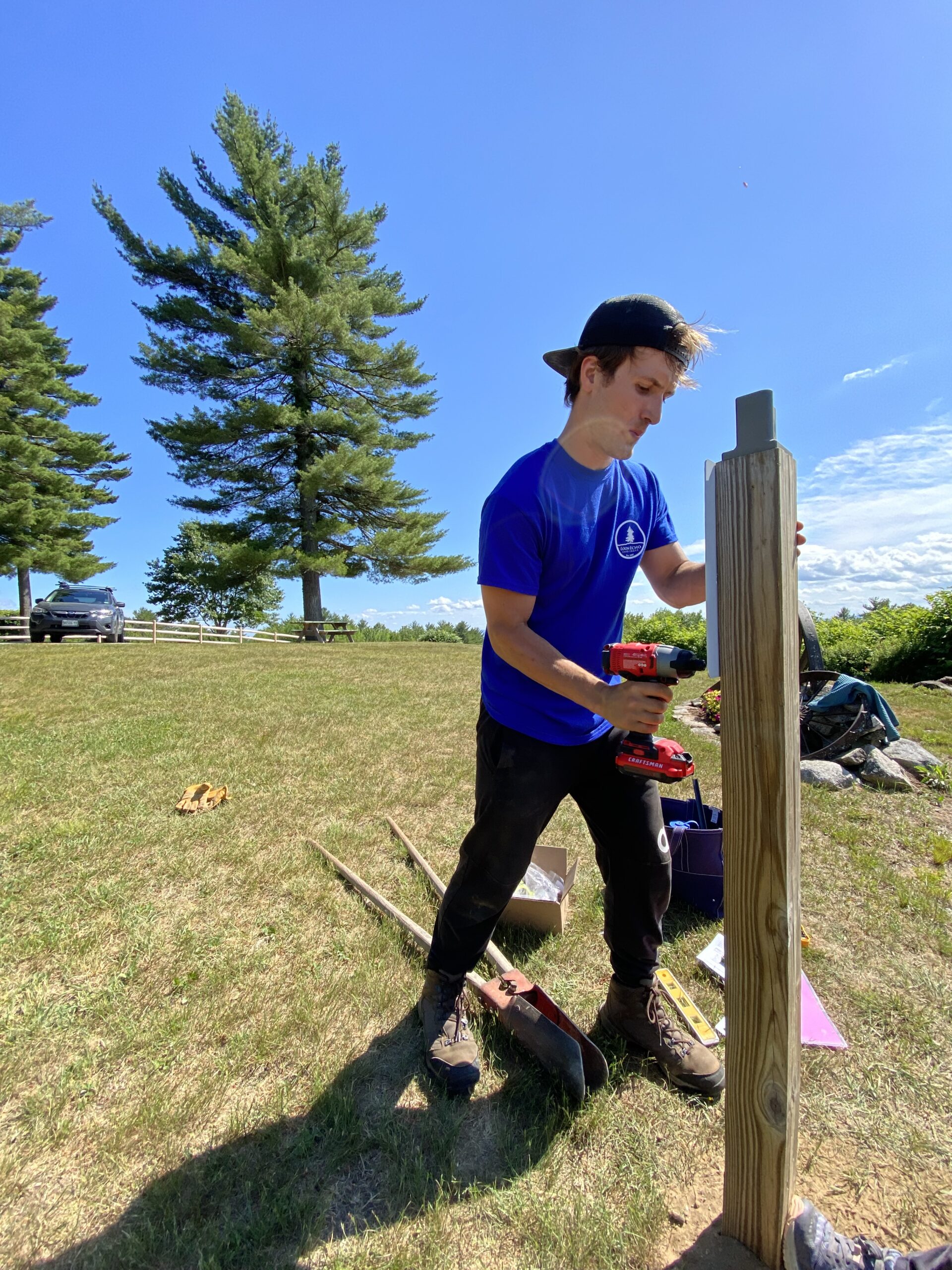
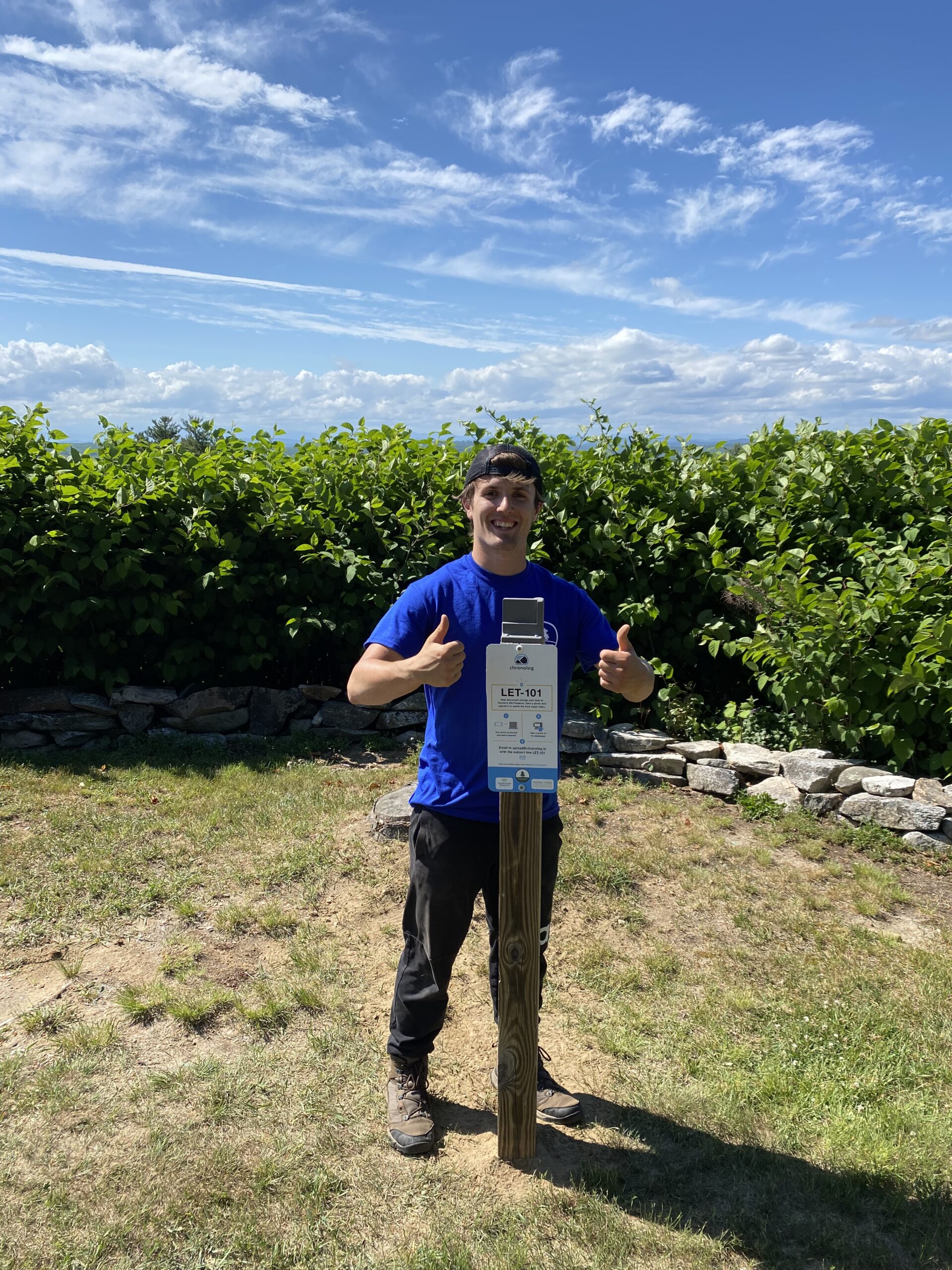
“Eventually the goal would be to eradicate this invasive species from the site, but that could take up to 5 years. The first step was to cut most of the stand, which stood about 10 feet tall. When the regrowth is 3-4 ft tall, a careful herbicide treatment will be applied only to the knotweed.
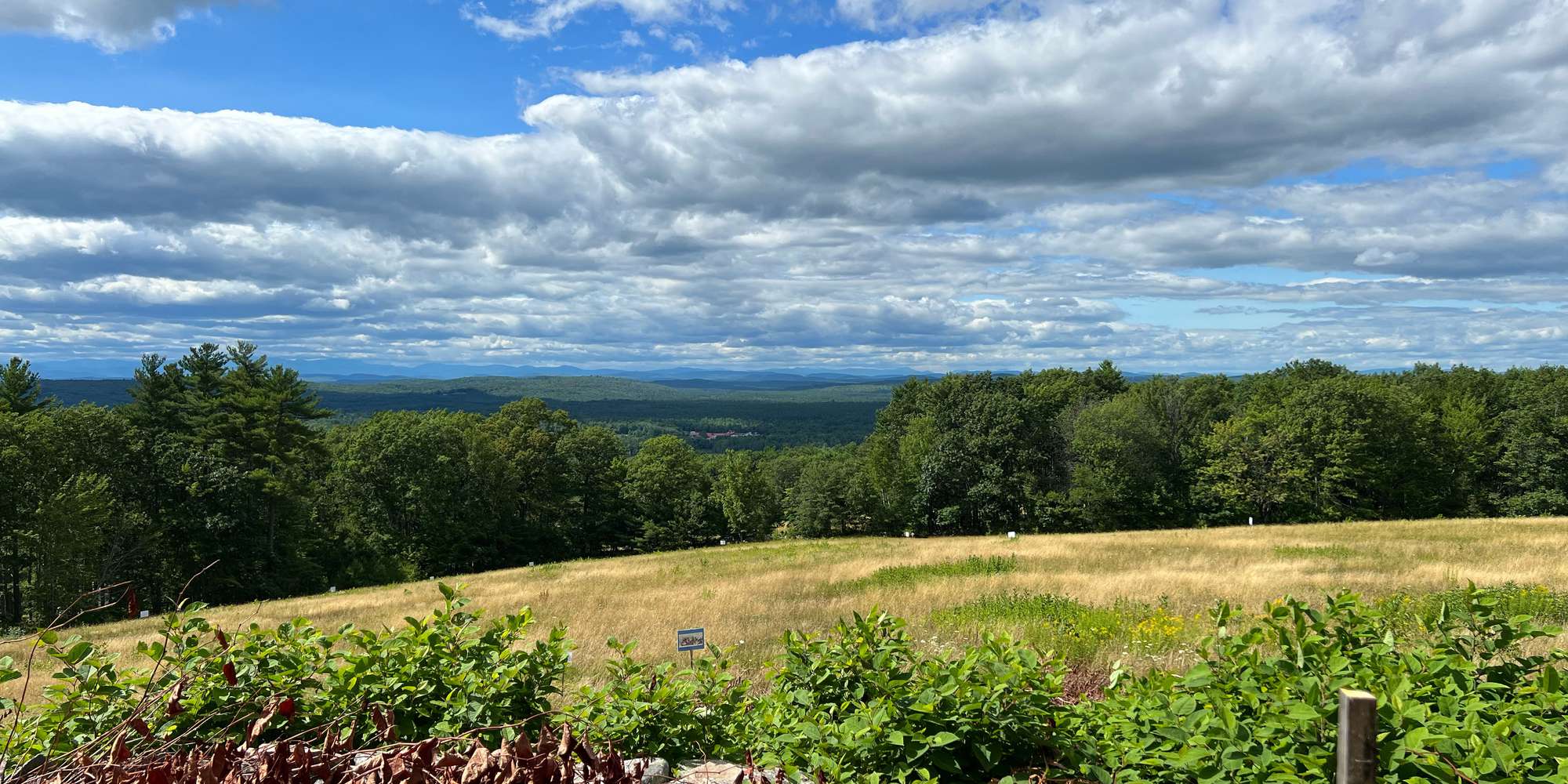
Just out of sight to the left of the Climate Change Observatory post, part of the stand was left upright, and we intend to treat that area with stem injection treatment (knotweed stems are hollow). We would like to see whether the cut-regrow-treat method or the injection method is more effective. Whichever treatment regime is most effective will be used again in subsequent years.
If treatments are effective, the Climate Change Observatory time lapse will capture the tops of knotweed plants from time to time, as we will let it re-grow before treating again. In time, we hope that the area will be free of knotweed and native plants can be established. These will probably be low-growing plants like grasses, american fly honeysuckle, and grassland flowers that can persist in tough conditions and keep invading plants out.” — Cheri Brunault
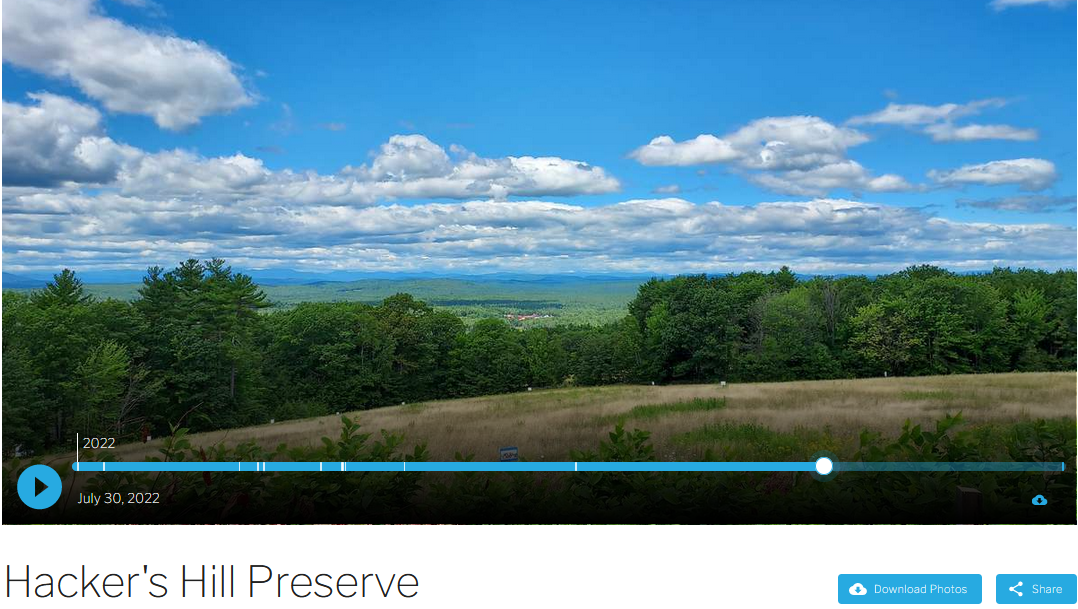
SMCC Welcomes our 2022 Summer Associates to the team
The Southern Maine Conservation Collaborative is excited to have Chas Van Damme and Madison Sheppard join our team this summer.
MEET CHAS:
“Hello! My name is Chas and I couldn’t be more excited to be working with SMCC and MEEA this summer! I am a rising Senior at Bates College studying Environmental Studies with a focus in Global Environmental Politics. I’m an avid hiker, love to bike, and will eat just about anything you put in front of me!
As climate change continues to surface its ugly head throughout the world, its impacts have only grown in scale. This couldn’t be more evident in my hometown of Harpswell, where eroding peninsulas stretch far into the fastest-warming ocean body in the world, and the once booming lobster industry now faces projections of drastically declining lobster populations. Seeing first-hand the impacts of human-induced climate change has largely motivated me to find ways to play an active role in reducing these issues at their core. Having worked with a local land trust as a field team member last summer, I got my hands dirty by manually eradicating invasive species, managing trail erosion, and even caring for recently-planted American Chestnut seedlings. Now, I am thrilled to have the opportunity to continue similar work, but at the research and investigative level by working with SMCC and MEEA on a wide array of projects, each of which uniquely contributing toward improving and rehashing more equitable relationships with the world around us. Through SMCC, its members, and MEEA, I am especially interested in deepening my understanding behind the politics of conservation and working to mitigate the disproportionate impacts that BIPOC and low-income communities continue to face when it comes to environmental harm. It’s going to be a great summer and I can’t wait to start learning from all the wonderful people working tirelessly to protect this region we call Maine.”
MEET MADISON:
My name is Madison and I am a 21 year old artist and activist living in Western Maine. I spent most of my life where I grew up, in Cape Cod, MA. We lived close to the ocean, which aided my passion for shark conservation. I wanted to be a marine biologist growing up, and spent a lot of time at the science labs in Woods Hole Oceanographic Institution at the age of 11. This position will help me get started in conservation work, where one day I can help protect endangered species and habitats… maybe I’ll start with some sharks :). I am now a college student currently majoring in biology and astrophysics.
OUTLOOK with Zofia Leary-Forrey
Outlook explores variables that shape and influence individuals relationships with nature and how they seek to inspire, adapt and reimagine what conservation can look like moving forward in a world where Climate Change is affecting a broad range of human and natural systems.
Author: Zofia Leary-Forrey, SMCC Spring Intern. A rising senior at Cape Elizabeth High School and part of the CEHS Environmental Club.

OUTLOOK: Chats and insights with students ages 14-18 about Climate Change.
This Spring, Zofia Leary-Forrey, a rising senior at Cape Elizabeth High School, set out to learn more about how youth connect with the natural world and their response to Climate Change. Through meeting and interviewing many students, ages 14 to 18, she was able to get an array of perspectives and insight into what the younger generation is feeling and thinking about climate change.
A COLLECTION OF VOICES
By Zofia Leary-Forrey
Every person has a different experience with nature. Some have them on the water, others in the mountains, some in the forest, during the first snowfall, and on long walks. “It’s fun to be in the sun all day,” and “[immerse] myself into the sounds, smells and beautiful images” of nature. It is fun to use nature to connect with my sisters, grandmothers, and parents. We worry that these shared experiences with family, friends, and nature will end as technology advances. “Younger kids are given iPads,” breaking their possible connection to the natural world. They spend hours watching Cocomelon instead of being outside painting rocks or building fairy houses like we did when we were kids. Younger kids will not get the same experiences as we, or our parents, or grandparents did. Our generation doesn’t even get to experience nature at its best, and “nature deserves to be at its best.” “[We] try to appreciate nature more,” but as time moves forward we notice the creeping tides, slushy snow, warmer waters, and shorter winters. “The world is ending,” and we have “no power, no money, and little education on what to do.”
We are angry. Angry at older generations, corporations, and our educational systems. We want to believe our generation can be the ones to bring change, but it is difficult when we are not the ones responsible for causing the issue and when the impacts are harder to visualize. We wish that “the lack of compassion for the planet” was not a looming presence, but misinformation and misconnection have created a rift between humans and the environment. We feel defeated when we realize “one person can not take down an entire corporation,” then annoyance leeches in when we see that all the corporations do is “greenwash.” We want to be sustainable, but oftentimes it is inaccessible. We wish we could say that we were climate activists, but the resources are not always there. Our future is “weak” and “bad” if this cycle continues. “[We] want to have a future”, we want “the skinny polar bears in the Arctic to live,” we want “the little bugs that crawl into [our] homes” to live, and we “would like to live.” To do this, “we need to band together to break the cycle ~ this earth does not equal money. ”
We are doing what we can in the ways we know how by recycling, composting, shopping second hand, eating less meat, shopping local, using our cars less, and educating ourselves. However, a lot of the time these practices feel small. We are hopeful for a greener future, and we will start by each doing our parts. As a generation, we were raised to “stand up against bullies and to support victims,” today, tomorrow, and in the following, we will do just that. We will stand for the animals, the mountains, the lakes, the oceans, the trees, and our futures because as the youngest generation, we understand there is no time left.
April 2022- E-Newsletter
Summer Associate Job Post
The Southern Maine Conservation Collaborative (SMCC) and the Maine Environmental Education Association (MEEA) are teaming up to offer two full-time Summer Associate positions. This collaborative position is a unique experience to learn about and assist with both conservation and environmental education.
Position: Summer Associate (2 positions)Pay rate: $19/hour (over a 10 week period)Preferred Start Date: June 6, 2022 (flexible)Application Deadline: April 20, 2022
ABOUT THE ORGANIZATIONS
The Southern Maine Conservation Collaborative (SMCC) is a non-profit organization with the mission to work collectively in Maine to create mutually beneficial relationships with the earth, communities, and people through the conservation movement. SMCC works with many conservation organizations in Maine to amplify, support, and build capacity in their work. Our work improves the coordination and effectiveness of numerous organizations that work on protecting land and water by providing professional support services, collaborative learning, resources, and networking opportunities. The Maine Environmental Education Association (MEEA) is also a non-profit organization with a mission to enhance and amplify the efforts of individuals and organizations building environmental awareness, appreciation, understanding, and action in Maine. MEEA works with a wide network of environmental educators, students, organizations, and other individuals across the state. MEEA envisions a just and sustainable Maine where interconnectedness with the natural world is the root of environmental and social responsibility of all individuals, institutions, and communities.
COMMITMENT TO EQUITY AND INCLUSION
Both SMCC and MEEA are committed to building more inclusive and equitable conservation and environmental movements in Maine. Our organizations are actively leaning into the intersection of the environment, conservation, and social equity, and we are committed to weaving this intersection through all of our work. We are continuously learning about our blind spots and unconscious biases. We know that biases and disparities disproportionately burden communities of color, indigenous communities, people with physical and mental disabilities, and low-income communities with legacies of environmental damage and ongoing harm. It is our duty to ensure that our work does not propagate destructive, damaging practices, and instead is addressing barriers and fixing inequitable systems.
ABOUT THE POSITION
This summer, SMCC/MEEA is hiring two summer associates to attend to a variety of projects. Projects could use the skills and interests from individuals with a variety of backgrounds. These projects may include:
- Developing an overall understanding of conservation, including the conservation process (ex: easements, fee ownership, stewardship) and land justice
- Supporting the evaluation and outcomes of the Relearning Place Convening
- Engaging in equity-related programming and trainings including MEEA’s Beyond Statements Equity Calls
- Learning GIS skills and assisting with the mapping of conservation properties in Southern Maine as part of the Rapid Response Program
- Supporting tasks as needed related to the ongoing work of the Southern Maine Conservation Collaborative, which might include social media, conducting interviews, writing and contributing content/storytelling, photography/videography, surveys, reports, fundraising, research, administration, community engagement support and more
- Creating a story map and/or engaging in storytelling initiative as part of the Climate Change Observatory Network
- Conducting research and writing reports on land justice, equitable nonprofit structures, or other pressing issues
- Learn about non-profit administration, operations, and systems
- Engage in professional development opportunities including webinars, trainings, and conference opportunities.
The position will average 10 weeks between June – August and the hours per week may be between 30-40 hours depending on circumstances. The position is based out of the SMCC office in Portland and depending on state guidelines related to covid, could be a combination of remote and in person. The position might include travel, primarily in Southern Maine (Federal rate reimbursable if work travel is conducted in personal vehicle). It is not required that you have your own car or computer.
SUGGESTED SKILLS
- Ability to collaborate effectively with a diverse range of people and organizations
- Strong verbal and written communication skills
- The ability to stay organized and communicate effectively working in a remote or hybrid work environment
- Basic proficiency in Microsoft Office, GSuite products, and Airtable
We are committed to supporting your learning and training in skills development and experience and will provide funding towards these development opportunities.
REQUIREMENTS
- An enthusiasm and commitment to equitable, inclusive, and just conservation and environmental movements.
- Be between the ages of 18 – 30 and willing to live and work in Southern Maine this summer.
- Independent, self-directed worker having the ability to work closely with people from diverse backgrounds and foster collaboration.
- Flexibility and comfort with working on multiple tasks.
HOW TO APPLY
Please send your resume, a list of 2 references, and a cover letter that contains responses to questions below to conservationcollaborative@gmail.com – please include ”Summer Associate 2022” in the email subject line.
- Why do you feel that you are a strong candidate for this position?
- How do you hope this experience will serve you, your work, and your community?
- What specific part of this position description resonates most closely with your life experience and/or your vision for the future?
Please address your cover letter to Jessica Burton.
SMCC reserves the right to conduct background checks as a condition for employment. Southern Maine Conservation Collaborative is an Equal Opportunity Employer.
THANK YOU FOR YOUR INTEREST! WE LOOK FORWARD TO HEARING FROM YOU.
March 2022 – E-Newsletter
Collaborative Conservation for Climate, Community, and Cohesion
In the past few years, the collaboration known as the Rapid Response Team for York County Conservation has been working to pursue larger-scope conservation projects in the Southern Maine region, with promising successes so far. The Rapid Response Team (RRT) is comprised of the Saco Valley Land Trust, Francis Small Heritage Trust, and the Three Rivers Land Trust, all members of SMCC. SMCC initiated this group in 2019 with a grant from an anonymous private foundation and Jess has continued to play the role of convener, facilitator, and support.
Together, the RRT members decided on a focus for their efforts – speeding resources to support large-scale land conservation projects having a regional impact specifically related to equitable access, climate resiliency, and contiguity. We know that this region’s character is threatened by continuing development, fragmentation, and disruptive land use. York County is unique and significant because it contains some of the state’s most valuable timberland, high biodiversity, accessible recreation areas, and some of the most climate-resilient landscapes. Southwestern Maine has tremendous capacity to help Maine reach its climate goals by sequestering carbon in its forests while also providing economic opportunity and ecological benefit. And yet, most of the land protection work in western York County, where these large blocks of forest remain, is pursued by the efforts of three small, minimally staffed land trusts.
In 2020, the team received funding ($180,000) from the anonymous foundation to help secure a 550-acre property now known as the Sanford Community Forest. This early funding was received by Three Rivers Land Trust early in their fundraising effort and as such not only provided resources to cover early expenses like survey and environmental assessment costs, but also served as match and proof-of-viability for other granting programs and major donors. The land trust ultimately raised about $780,000 from a variety of sources and successfully acquired the land. Without the vote of confidence and connection to early funding through the RRT, this project would have been a longer and more difficult struggle to complete, if it was successful at all.
In 2021, the RRT engaged Cheri Dunning as a Conservation Project Assistant to work with the individual land trusts and further the goals of the RRT. As part of the Cheri’s work, the Francis Small Heritage Trust successfully proposed the Porter Hills Conservation Initiative as a RRT project and received funding ($100,000) to assist the early work of this ambitious project, which has the potential to conserve up to 1,200 acres in and near the state-designated Focus Area of the Porter Hills. Cheri is now helping the land trust to apply to the Land for Maine’s Future program to assist with the same initiative.
The Saco Valley Land Trust is now also developing a conservation project to propose to the RRT, contributing to regional conservation efforts and keeping up the momentum of this collaboration. The RRT assistant is working with SVLT to structure the project and determine funding needs.
The original vision for the Rapid Response Team was a working group that increases the speed, scale, and regional impact of land conservation in southwestern Maine, with clear priorities, shared capacity, and the ability to quickly act on conservation projects that might otherwise be out of reach. So far, the RRT has had great success following that goal, and we expect and hope to see it continue.
Photo: Boards of Three Rivers Land Trust and Mousam Way Land Trust at Sanford Community Forest.
Photos: stream, bog, and wetlands in the Porter Hills Conservation Project & Sanford Community Forest.


